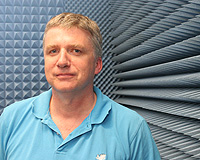Home > Press > Ultra-secure quantum communications
 |
| Secure link ... Rob Malaney |
Abstract:
The risk of sensitive information falling into the wrong hands could be eliminated by a new quantum communication process that delivers unprecedented security.
Ultra-secure quantum communications
New South Wales | Posted on May 24th, 2010UNSW telecommunications researcher Robert Malaney has developed the process, called "unconditional location verification", which ensures that even if an encryption password has fallen into the wrong hands, a secure message can only be seen by a recipient at an agreed geographic point.
Associate Professor Malaney, of the UNSW School of Electrical Engineering and Telecommunications, said quantum communications already allow unbreakable encryption but security can now be further enhanced using unconditional location verification.
"This takes communications security to a level that hasn't previously been available," he said.
"With this process you can send data to a person at a particular location. If they are not at that location the process would detect that and you can stop the communication.
"This is a new application that you can deploy on current and emerging quantum networks. It opens up a range of new information security applications for both fibre and wireless communication networks.
"There would be many industries and organisations, banks for example, that would be interested in delivering information content in the sure knowledge a recipient is at an agreed-upon location."
The concept, which also has potential applications in the intelligence community, e-commerce and digital content distribution, is reported in the April edition of the American Physical Society journal Physical Review A.
The system works by sending paired "qubits" - particles, such as photons, which have been manipulated to contain specific quantum information - over a fibre optic or wireless network to a recipient. The recipient must send a return message, using information from the decoded qubits, to a number of reference points to open up a secure channel. Because quantum networks operate at the speed of light and quantum information cannot be copied, the time to return the message can be accurately measured, ensuring that it has come from only one possible place.
####
For more information, please click here
Contacts:
Media Contact:
Associate Professor Rob Malaney
02 9385 6580
UNSW Media Office:
Peter Trute
02 9385 1933
Copyright © University of New South Wales
If you have a comment, please Contact us.Issuers of news releases, not 7th Wave, Inc. or Nanotechnology Now, are solely responsible for the accuracy of the content.
| Related News Press |
News and information
![]() Researchers develop molecular qubits that communicate at telecom frequencies October 3rd, 2025
Researchers develop molecular qubits that communicate at telecom frequencies October 3rd, 2025
![]() Next-generation quantum communication October 3rd, 2025
Next-generation quantum communication October 3rd, 2025
![]() "Nanoreactor" cage uses visible light for catalytic and ultra-selective cross-cycloadditions October 3rd, 2025
"Nanoreactor" cage uses visible light for catalytic and ultra-selective cross-cycloadditions October 3rd, 2025
Possible Futures
![]() Spinel-type sulfide semiconductors to operate the next-generation LEDs and solar cells For solar-cell absorbers and green-LED source October 3rd, 2025
Spinel-type sulfide semiconductors to operate the next-generation LEDs and solar cells For solar-cell absorbers and green-LED source October 3rd, 2025
Academic/Education
![]() Rice University launches Rice Synthetic Biology Institute to improve lives January 12th, 2024
Rice University launches Rice Synthetic Biology Institute to improve lives January 12th, 2024
![]() Multi-institution, $4.6 million NSF grant to fund nanotechnology training September 9th, 2022
Multi-institution, $4.6 million NSF grant to fund nanotechnology training September 9th, 2022
Announcements
![]() Rice membrane extracts lithium from brines with greater speed, less waste October 3rd, 2025
Rice membrane extracts lithium from brines with greater speed, less waste October 3rd, 2025
![]() Researchers develop molecular qubits that communicate at telecom frequencies October 3rd, 2025
Researchers develop molecular qubits that communicate at telecom frequencies October 3rd, 2025
![]() Next-generation quantum communication October 3rd, 2025
Next-generation quantum communication October 3rd, 2025
![]() "Nanoreactor" cage uses visible light for catalytic and ultra-selective cross-cycloadditions October 3rd, 2025
"Nanoreactor" cage uses visible light for catalytic and ultra-selective cross-cycloadditions October 3rd, 2025
Military
![]() Quantum engineers ‘squeeze’ laser frequency combs to make more sensitive gas sensors January 17th, 2025
Quantum engineers ‘squeeze’ laser frequency combs to make more sensitive gas sensors January 17th, 2025
![]() Chainmail-like material could be the future of armor: First 2D mechanically interlocked polymer exhibits exceptional flexibility and strength January 17th, 2025
Chainmail-like material could be the future of armor: First 2D mechanically interlocked polymer exhibits exceptional flexibility and strength January 17th, 2025
![]() Single atoms show their true color July 5th, 2024
Single atoms show their true color July 5th, 2024
![]() NRL charters Navy’s quantum inertial navigation path to reduce drift April 5th, 2024
NRL charters Navy’s quantum inertial navigation path to reduce drift April 5th, 2024
Industrial
![]() Quantum interference in molecule-surface collisions February 28th, 2025
Quantum interference in molecule-surface collisions February 28th, 2025
![]() Boron nitride nanotube fibers get real: Rice lab creates first heat-tolerant, stable fibers from wet-spinning process June 24th, 2022
Boron nitride nanotube fibers get real: Rice lab creates first heat-tolerant, stable fibers from wet-spinning process June 24th, 2022
![]() Nanotubes: a promising solution for advanced rubber cables with 60% less conductive filler June 1st, 2022
Nanotubes: a promising solution for advanced rubber cables with 60% less conductive filler June 1st, 2022
Quantum nanoscience
![]() ICFO researchers overcome long-standing bottleneck in single photon detection with twisted 2D materials August 8th, 2025
ICFO researchers overcome long-standing bottleneck in single photon detection with twisted 2D materials August 8th, 2025
![]() Programmable electron-induced color router array May 14th, 2025
Programmable electron-induced color router array May 14th, 2025
|
|
||
|
|
||
| The latest news from around the world, FREE | ||
|
|
||
|
|
||
| Premium Products | ||
|
|
||
|
Only the news you want to read!
Learn More |
||
|
|
||
|
Full-service, expert consulting
Learn More |
||
|
|
||








